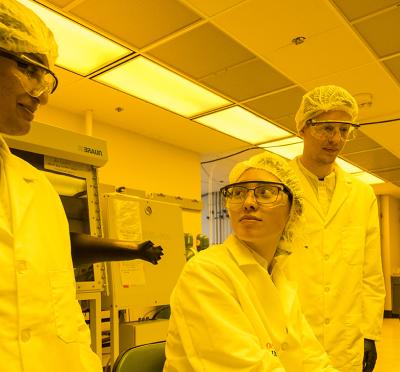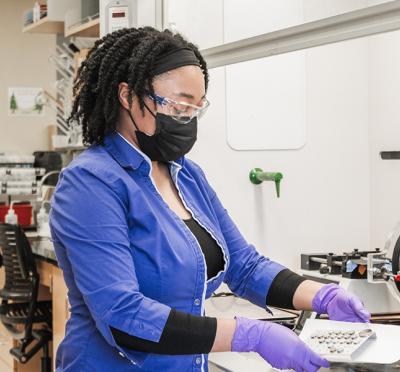
Assistant Professor Somayeh Pasebani measures the dimensions of a 3D-printed stainless steel bar.

A 3D-printed lattice structure made from stainless steel powder.
Somayeh Pasebani grew up in a family of eight children in Tehran, Iran, where her father owned a small auto mechanic shop. As a young girl, Pasebani took things apart, trying to understand how they worked, but she often couldn’t figure out how to put them back together again.
Oregon State Researcher in Lab
Assistant Professor Somayeh Pasebani measures the dimensions of a 3D-printed stainless steel bar.
“I actually damaged a lot of things,” said Pasebani, now 38. She wanted to be her father’s auto shop assistant, but it wasn’t common in Iran back then for girls to do such things. So instead, she became his assistant at home when he was working on projects around the house. She happily handed him the tools he needed — wrenches and hammers, nails and screwdrivers.
That was the first time Pasebani remembers being fascinated by metals. She wondered how the oddly shaped, hard steel tools were made.
In high school, her childhood fascination was fueled by a female chemistry teacher who taught the class how to make aluminum alloy from bauxite using the reduction process developed in 1886 by Charles Martin Hall, an American chemist and inventor, and one of the founders of Alcoa Corp.
“I was fascinated by the Charles Martin Hall method, and he was the reason I studied metallurgy,” said Pasebani, one of only two people in her immediate family to attend college.
Pasebani’s research explores additive manufacturing that is poised to revolutionize the way metal parts are made for aerospace, energy, biomedical, tooling,
After earning her doctorate in materials science from the University of Idaho and working for three years in the metal powder industry in Pennsylvania, she joined the College of Engineering at Oregon State University in 2016 as an assistant professor of advanced manufacturing. She now leads cutting-edge research in additive manufacturing that is poised to revolutionize the way metal parts are made for aerospace, energy, biomedical, tooling, and other industries.
“Basically, we’re doing 3D printing using metals,” she said. “Additive manufacturing can reduce the numerous steps involved in conventional manufacturing.”
By tapping 3D printing technology and using selective laser melting, or SLM, of powder metals, Pasebani can create “near net shape metal parts,” or parts that can have complex geometries and don’t require hot deformation or machining. This cuts costs, saves resources, and reduces production time.
But what sets Pasebani’s research apart is that she uses inkjet technology to apply small amounts of oxides onto the metal powder before it is melted with the laser. This hybrid jetting method using SLM enables a range of characteristics to be “programmed” into metal parts, creating what are called oxide dispersion strengthened alloys, or ODS.
3d object printed in engineering lab
A 3D-printed lattice structure made from stainless steel powder.
“This is something no other technology can do,” Pasebani said. “Several research groups in the U.S. are working with SLM, but nobody else is jetting a second phase material to the powder bed and creating a metal matrix composite via a hybrid approach.”
In the energy sector, parts can be manufactured for high-temperature applications — such as solar thermomechanical reaction systems and heat exchangers — at significantly lower costs. Nickel, the go-to metal for high-temperature applications, is expensive and challenging to machine. Inkjet technology enables the precise addition of very small amounts of yttrium oxide to an iron-based composite that costs one-third to one-half as much as nickel but works well at high temperatures.
Although ODS metals have been available for two decades, conventional methods are complicated and extremely time-consuming. And the mixed material still requires hot deformation and traditional machining, making the process too expensive for general applications.
But the ultimate advantage of additive manufacturing in alloy development is that it enables precise variation in the composition of the material. The application of oxides using jets can be controlled down to the nanoscale to attain gradient composition across a single part, so parts can have tailor-made characteristics of strength, hardness, or porosity in different areas.
In biomedical applications, for example, Oregon State’s technology can vary the porosity within custom metal parts tailored to individual patients for use in bone or dental structure repair. Porous areas foster better bone growth, or scaffolding, to the metal parts.
“That is very hard to do using conventional subtractive manufacturing methods,” Pasebani said.
Although she misses her family in Iran, Pasebani is happy to be in the Pacific Northwest with her husband, Mazdak Shadkam, who holds both a chemical engineering degree and a master of fine arts. He teaches and conducts research in art and STEM (science, technology, engineering, and math) integration at Oregon State.
“I wake up every day knowing I can contribute and be happy in this place,” Pasebani said. “That’s why we love Oregon State.” The couple recently had their first child, a boy.
Pasebani’s research explores additive manufacturing that is poised to revolutionize the way metal parts are made for aerospace, energy, biomedical, tooling,




